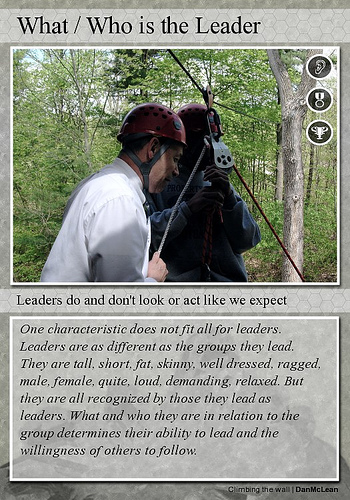Demonstrate leadership skills in a tour context/Activities/What is leadership

Contents
Objectives
Understand leadership skills
Activity
Describe a range of leadership styles, and identify traits of what makes up a leader
Task
- Read through the following questions and answers below
- Look at the supporting materials
- In your own words, suggest the traits and characteristics for your idea of a model leader
Is there a difference between Leadership and Management?
The biggest difference between managers and leaders is the way they motivate the people who work or follow them, and this sets the tone for most other aspects of what they do. There are however some people who are both managers and leaders. Managers generally have subordinates while leaders have followers. The table below gives a good idea of the differences between a leader and a manager.
| Subject | Leader | Manager |
|---|---|---|
| Essence | Change | Stability |
| Focus | Leading people | Managing work |
| Have | Followers | Subordinates |
| Seeks | Vision | Objectives |
| Detail | Sets direction | Plans detail |
| Power | Personal charisma | Formal authority |
| Appeal to | Heart | Head |
| Energy | Passion | Control |
| Dynamic | Proactive | Reactive |
| Persuasion | Sell | Tell |
| Style | Transformational | Transactional |
| Exchange | Excitement for work | Money for work |
| Risk | Takes risks | Minimizes risks |
| Rules | Breaks rules | Makes rules |
| Conflict | Uses conflict | Avoids conflict |
| Direction | New roads | Existing roads |
| Blame | Takes blame | Blames others |
Are there different leadership styles?
There are three (4) classical leadership styles.
The Laissez Faire: This largely ‘hands off’ view that tends to minimize the amount of direction and face time. This works well if you have highly trained and highly motivated people around.
The Autocratic: This leadership style is more direct and controlling. People tend to be more oriented toward productivity and goals. Their strength is to get things done and make quick decisions. Autocratic leaders take authority and go head first in solving problems. They like freedom to manage themselves and others. They tend to measure their success by the items of tasks/ activities they get done.
The Democratic Style: This leadership style requires input from others. People tend to be more concerned about the process of how the decisions are made and that everyone has a voice. Participatory leaders tend to make decisions in a slow, thoughtful process. Generally, these people are good listeners and cooperative.
The Charismatic: Charismatic leaders tend to be very good listeners and great information gatherers. They like to expose themselves to a wide range of individuals in order to get new ideas. Charismatic leaders create a sense of purpose for their organisation that is motivating and inspiring.
Can leadership be taught?
There is the constant debate of whether leaders are born or bred. Some believe that no amount of training can make someone rise to be a leader unless they are born with a ‘leadership gene’. Others take the view that leadership skills can be at least be enhanced, if not developed from scratch, by experience, training, mentoring and circumstance. All it takes is for a person to step forward or step up.
How can I motivate people?
Motivating someone is not that easy. A person can only motivate themselves. A good leader however can create an environment in which this motivation can occur. However deep and complex human nature is all humans share basic needs that must be addressed, ranging from shelter to more sophisticated drives. A hierarchy of needs shows us what we need for motivation.
Physiological Needs: Basic physical needs: the ability to acquire food, shelter, clothing and other basics to survive
Safety Needs: A safe and non-threatening work environment, job security, safe equipment and installations
Social Needs: Contact and friendship with fellow-workers, social activities and opportunities
Ego: Recognition, acknowledgment, rewards
Self-Actualization: Realizing one's dreams, using one's gifts, talents and potential. Once basic needs are satisfied, people want more. Progress is the essence of human nature. When people's basic needs are addressed, their mind and soul, free of threat and insecurity, open up to some of their innermost drives. If we discover who every worker is, his/her drives, special gifts, abilities, hopes and plans for the future. If we take time to discover this, understand what makes this person "tick", we will be able to utilize this worker in the position which is the best "fit", a step ahead towards employee motivation.